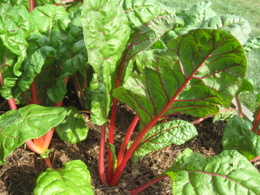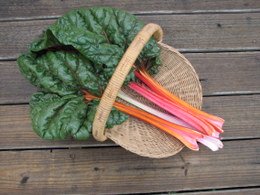Swiss Chard Growing Guide
Swiss chard is also simply called chard and is one of the most nutritious and productive vegetables you can grow in your garden.
It is a very attractive plant with light to dark green foliage and stem colors of white, red, orange, purple or pink.
A seed package labeled Bright Lights is a mix of colors. The seedlings can be left as they are or segregated by color. The multi-colored stalks are very attractive in the garden. It is related to beets and spinach and has its origins from the Mediterranean Sea area. It gets its name from a botanist from Switzerland, who first described it.
It is a biennial making it resistant to bolting and grows well throughout the season until killed by a hard freeze.
Soil Preparation
Swiss chard likes a nice loose well-drained garden soil. Add compost and blend in before planting. It prefers full sun, but can tolerate some light shade, especially during the hot summer weather. Soil pH should be 6.0 to 6.8.
Starting from Seed
Follow the seed packet instructions, seeds can be started indoors 6 to 8-weeks before your last expected frost date.
Sow the seeds 1/2-inch deep in a sterile seed starting mix in cell packs or pots. Lightly cover with the seed starting mix and keep moist. Germination takes 7 to 14-days.
Bottom watering is the easiest way to keep moist without disturbing the newly sown seeds.
Plants can be set out in the garden 4 to 6-weeks before the last frost spaced 12 to 18-inches apart.
For more detailed information visit the seed starting page.
Planting Swiss Chard
Swiss chard seeds can be direct sown 2 to 3-weeks before your last expected frost. The seeds are a cluster that will produce more than one plant and can be separated after germination. Lightly cover the seeds and gently water them in.
Space Swiss chard 12 to 18-inches apart. The leaves can reach 20 to 30-inches high. It grows well in containers.
Swiss chard may seem slow getting started. Early on they are getting their roots established. Be patient and keep the soil moist and do not let them dry out.
Watering and Care
Water your Swiss chard during dry spells. Add mulch after it is a few inches high to prevent weed growth and slow down water evaporation.
Harvesting Swiss Chard
Swiss chard matures in about 45-days, but if you started your plants from seed you can start by thinning and removing any plants that are too close to others to give them more room to grow.
On young plants, be careful when removing leaf stalks. You do not want to pull the plant out of the ground or disturb its roots. Use a sharp knife to cut 1 or 2 outer leaf stalks at the base of each plant taking care not to injure the new leaves growing from the central crown.
After rinsing off the young tender leaves they can be added to a salad as greens. Most will sauté, steam or boil Swiss chard just as you might prepare spinach, kale, and mustard greens. Some prefer just cooking the leaves and discarding the stalks. The stalks may resemble celery but are not stringy. First dice the stalks into ½-inch pieces and start them cooking and then cut up the leaves and add them to the stalks to finish cooking.
Established plants are very frost tolerant down to the low 20-degree range and will continue to grow. Depending on your growing zone you may be harvesting up to and perhaps past Christmas. A light row cover can be used to cover your chard overnight to give some protection on the heavier frost nights.
Popular Varieties
Popular varieties: El Dorado, Fordhook Giant, Red Magic, Bright Lights, Rainbow.
Sources: Seeds Now, Burpee, Johnny’s Selected Seeds
Diseases and Pests
Downy mildew and cercospora leaf spot are common in some areas. Choosing resistant varieties and maintaining good air circulation around the plants are the best ways to avoid any problems. If you see any holes in the leaves, aphids and caterpillars are the likely cause.
The easiest way to deal with aphids without using chemicals is to knock them off with a spray of water. Ladybug beetles will eat many aphids. Many gardeners will purchase them and release them in their garden to help control the aphids that are a problem with many plants.
Serious infestations can be controlled with an organic product such as insecticidal soap or neem oil. These are both organic controls that are very effective.
Caterpillars are best controlled by hand picking them or applying BT (Bacillus thuringiensis) to kill the caterpillars.
Tips and Warnings
Swiss chard contains oxalic acid which is present in spinach, beets, okra, and rhubarb as well in smaller amounts in most of the vegetables we eat. If you are prone to getting kidney stones you may want to reduce the amount of foods that are high in oxalic acid.
Garden Spikes newsletters give you timely information once or twice a month. Subscribe Free to the Garden Times newsletter below.
Your email address will only be used to send you a newsletter and will never be sold. You can unsubscribe at any time.


